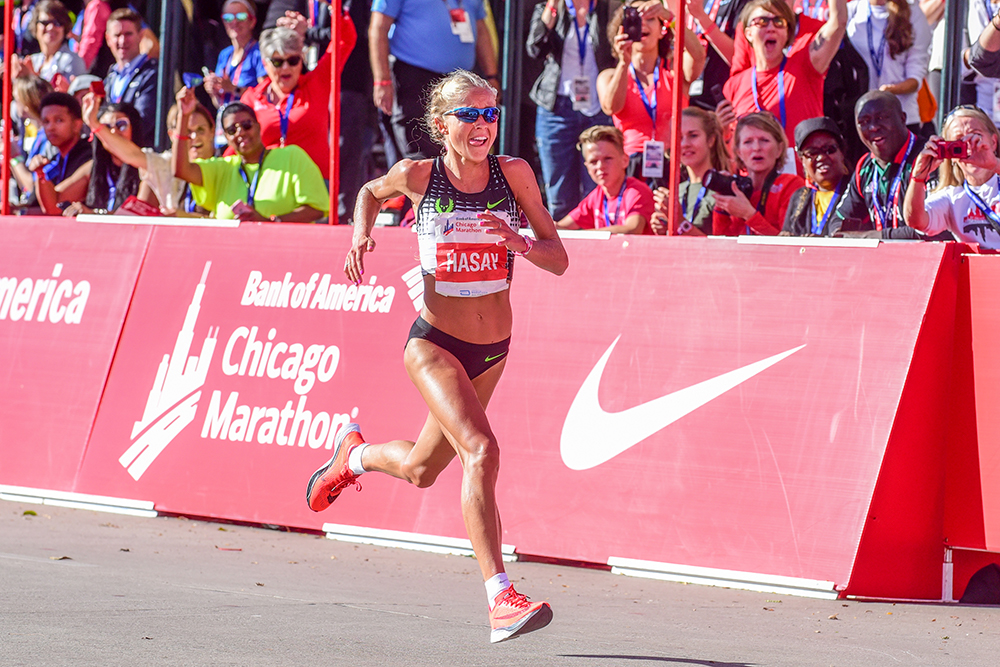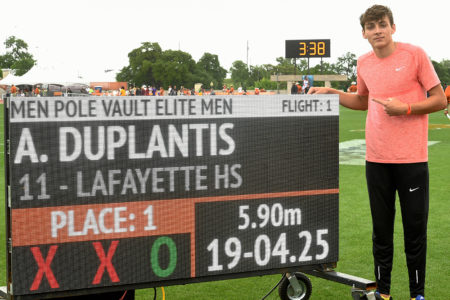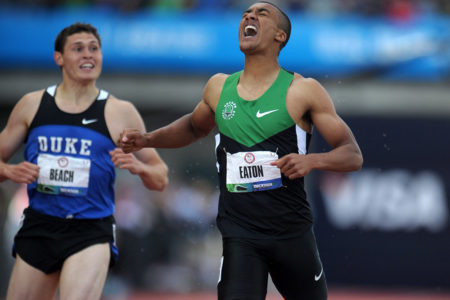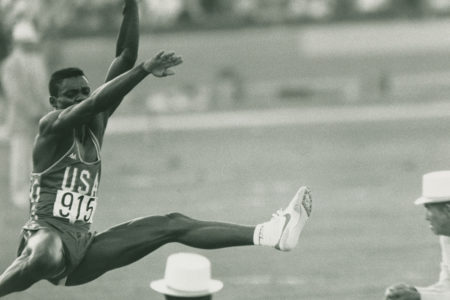Some major U.S. performers are fighting their way back from sit-downs of various kinds during the 2018 campaign. Here are our updates on Donavan Brazier, Morolake Akinosun, Jordan Hasay, Devon Williams & Shannon Rowbury.

Donavan Brazier
With a race under his belt in January, one of all-time significance at that, Donavan Brazier can give voice to what’s been eating at him since early last outdoor season. “When you’re a runner you always want to compete, you always want to race,” says the 800 man who crept ever closer to the American Indoor Record over the course of three consecutive weekends last winter. “I was running so good indoors and I ended my last race with a disqualification [in the heats of the World Indoor Champs in England]. So I’ve been so anxious to start running again.”
On the home track of his alma mater, Texas A&M, on January 19 Brazier zipped 600m in 1:15.46, jumping to No. 5 on the all-time U.S. list and No. 10 on the world compilation. An opener like that makes a fine balm for anxiety, but Brazier fretted most of last spring and all summer.
An injury early in his outdoor prep phase kept the 21-year-old Michigan native, who motored 1:45.10 at the ’18 USATF Indoor, off the track all summer. “I went into [the World Indoor],” Brazier says, “didn’t get the outcome that I wanted. But I started training again for my outdoor season and I came up with an Achilles injury. My Achilles tendon’s been kind of really sensitive and I never really got on top of it.”
Brazier confesses that impatience exacerbated his woes: “I was always trying to think that it’s a 2- or 3-day injury when realistically it was going to take weeks for me to recover, and I think that’s what prolonged the injury for so long for me to completely miss my outdoor season.”
He is happy to report, though, that he had a team behind him. “I had all the medical support in the world,” Brazier says. “USATF helped me out. I flew out to Indianapolis and got an MRI on it, which was just doing the most. I didn’t really need all that, ultrasound would have been just fine. They just found a strain in there that was getting flamed up and it was really sensitive. Also the [Nike] Oregon Project was helping me out a lot. I went to some of their camps and was seeing their doctors and trainers and just getting the treatment that I needed. They’ve been helping to this day.”
Summer sojourns at NOP camps in Park City and Switzerland and hanging with the group at last year’s Nationals convinced Brazier to join them and work under coach Pete Julian in an enclave rife with middle distance talent: Clayton Murphy, Craig Engels, Yomif Kejelcha.
“This is the first time in my running that I feel I’m kind of going all in,” Brazier says, mentioning that Portland’s wet weather has required some getting used to. “I’m not in college anymore where I’m with college guys. I’m just with the Oregon Project, not much to really do except run out there, recover and do everything. So it’s just kind of about being all in. I’m hoping that this move will be a really good one for me. When you don’t run for such a long time you realize how much you actually take competing for granted.”
There’s no taking anything for granted this winter. “This weekend’s 800m at the New Balance Indoor Grand Prix is my first 800m race in almost a year and so I’m really looking forward to it!” he says. /Sieg Lindstrom/
Morolake Akinosun
From the moment Morolake Akinosun tore her right Achilles tendon early last year at an indoor meet in Lubbock, there were no guarantees the Olympic sprinter would be able to return to world-class level. What she could control was her attitude, and the way she has dealt with the injury could mean the 24-year-old Texas alum’s best years are still in front of her.
“I’m going to be better,” says Akinosun, who struck gold for her work in the heats on the 4×1 in Rio and then won the ’17 US Indoor title in the 60. “I’ve gotten stronger in the weightroom. I’ve had a year to work on things, technical things that will make me better. I got to figure out things I need to work on.”
Though she still doesn’t have definite plans on a return to racing, her workouts have convinced her that when she does get back in the blocks, she’ll be ready for something special. She tore her Achilles on January 27 at the Texas Tech Classic, an injury that actually occurred after she had crossed the finish line and ran into the mat at the end of the straightaway.
The comeback began 5 days later when she had surgery. “It was a perfect storm, if it had to happen, I got injured at the perfect time,” she says. “I was a full-go by October or November, so I’ve been going hard for a few months now. I don’t know exactly when I’ll go back to racing, sometime in the outdoor season, but nothing specific. World Championships is the big goal, that’s what everything is pointed to. I want to get a gold at USAs, then get a gold at Worlds.”
She does brighten up, though, at the thought of running in the Texas Relays, essentially her home meet. Akinosun brights up a lot these days. “It’s the first year I didn’t run track, completely removed from it,” she explains. “I knew I loved the sport, but that really showed me how much. Now I’m going to come back stronger.”
And quicker—her PR is 10.95—though she specifically doesn’t want to project what the clock will say. “I just want to be faster,” she says. “I don’t believe in setting goals in numbers, I think when you do that you limit yourself. If I say I want to run 10.8, I’ve limited myself.” Her attitude certainly doesn’t allow for limiting herself. /Bret Bloomquist/

Jordan Hasay
Jordan Hasay was more than happy to be done with 2018. After a sterling marathon debut with her 2:23:00 at Boston in ’17—followed by an even better 2:20:57 at Chicago that fall—the Oregon alum was looking forward to making further progress in the long run. But her buildup to last year’s Boston race produced a stress fracture in her heel—the calcaneus bone. She took a month off and carefully returned to running so that she could race again in Chicago in the fall. Pain struck again—the same heel. An MRI showed a different stress fracture in the same bone. More time off. More cross training.
Hasay admits it was a tough turn of events, but true to form, she finds a bright side. “I just tried to see it as a good rejuvenation,” she says. “I had moved to the marathon and had a lot of success. But this is really long term and I want to continue on for the long term. I just tried to take it as a step back and spent time with my family. I definitely just really missed running. I’ve never really gotten burned out; I’ve always enjoyed running. It’s been my passion.”
The 27-year-old California native got the green light to return to running in early November and returned to full volume in mid-January. As thrilled as she was to be back running, she found it to be a huge relief to be done with the intensive cross-training (“It really is”).
“I’m just so grateful every single day to finish my run. And it’s not only just being back in the normal schedule.” She explains that the initial runs when coming back can be stressful. “I would do a hard workout and just be worried that it’s going to flare up or be sore. It’s just so nice [now] to do a workout and then just focus on recovery and the next day know that I’m going to be able to run and do my normal thing.”
She has taken a number of steps with her support team to protect her heel in the future. “I was having a bit of a coordination issue on that heel, so we’re being really smart about that. And staying on soft surfaces more; I think that’s the main thing. Moving to the marathon I had done quite a bit more on the road and just kind of took a pounding on that foot. So we’re doing a lot more on the grass and staying away from the road.”
Looking ahead, Hasay will be racing in Boston this April. “I’m really excited. I think about it every day,” she says. She says trying to run at the Worlds in Doha is not off the table. “I would like to do an earlier fall marathon. We’ll just see how Boston goes, one thing at a time. The main thing is the long-term plan looking forward to the Trials in February.”
There will be no track anytime soon for her, she says, adding, “I can see a return in ’21 with the Worlds in Eugene. That’s probably the only place that I would want to run track again. But for now, I’ve just got to get my confidence back.”
Having missed the ’16 Olympics, it’s natural that Hasay has a timeline that’s aimed straight at Tokyo. She says, “I’ve always dreamed of running in the Olympics, but at the same time, I just try to focus on the process and the small wins and then it all adds up together. Having an injury like I did, it really does make you kind of get back into that process. It’s like, get excited about running a half mile or a couple miles, and then it slowly builds up and builds up. “If I’m running well and I continue to have success in the marathon, hopefully then [the Olympics] will happen. I feel I have a lot to accomplish in the marathon still. Hopefully making the Olympics will be one part, one piece of that.” /Jeff Hollobaugh/
Devon Williams
After winning finishing 2nd at the ’17 NCAA and placing 10th at the World Championships, Devon Williams’ fast-rising decathlon career hit a snag last year when he found himself with a tiny stress fracture in his big toe, specifically the sesamoid bone. The painful condition stopped him after he finished 3rd in the heptathlon at the USATF Indoor in February. “That pretty much set me down for all of outdoor season,” the Georgia alum says. “I’ve pretty much learned how to deal with injuries and I think this one, I dealt with the best out of all the injuries I’ve suffered throughout my career. I was pretty positive as I went through it.”
However, as injuries sometimes do, it brought along a good measure of soul-searching about what would be the best way to get to that promising future ahead. In the end, Williams, who had been training at the Chula Vista Center in California (as was his sister, Olympic heptathlete Kendell)decided to go back to his roots.
In June he and sis returned to Athens, Georgia, to work again with their college coach, Bulldog head Petros Kyprianou. They decided to hold off on Williams’ return to full-scale training until November: “I already knew I wasn’t going to compete outdoors. There was really no rush to get back to training, so I pretty much just went through rehab and was doing exercises to get the muscles strong again. I was still working on all of my throwing events in the meantime.”
Now the 25-year-old Williams, after 2-plus months back at it, is thrilled. “Everything’s going great,” he says. “Honestly, I feel like I’m in the best shape of my life, which is crazy because as you get older, people think that you start to decline. I actually feel like I’m in really good shape.”
We’ll see Williams undercover: “I’m kind of just using indoors to get the competitive feeling back because I didn’t complete at all outdoors. I want to win USAs, just kind of get that feeling back and get that competitive edge back.” He continues, “Outdoors of course the goal is to make the World Championships team, but I also want to win a USA Outdoors as well and then go from there. But the main goal is to get on that flight to Qatar.”
Of a potential challenge to new World Record holder Kevin Mayer, he says, “I’ve dedicated my whole life to being the best that I can and being the best, period. I feel like I am the best; I don’t have the best score out there yet, but I feel like my upside is super high. “I have things I need to sharpen up, of course, I have techniques that I’m still trying to get down, but I’ve always felt like my potential is really great. So yeah, I think that in a few years my score will be up there with his. That’s my goal. It isn’t to beat Kevin Mayer, you know what I mean? My goal is to score as much as possible. I have high expectations for myself.” /Jeff Hollobaugh/

Shannon Rowbury
It has been a year of life changes for Shannon Rowbury. She and miler husband Pablo Solares had a daughter, Sienna Rosaleen, on June 30. There also was a move from the Portland area back to her hometown, where she is a volunteer coach at the University of San Francisco.
“It’s been a fun new adventure,” she says. Sienna, she adds, “is certainly a huge motivation for me to create an example that she can be proud of and to, no matter what, be the best mom I can be.”
It also has meant channeling her running career into uncharted territory. “Coach Pete [Julian] has been awesome,” she explains. “He has been so supportive this whole pregnancy process. He helped me lay out what the next 6 months would look like in terms of goals. “Once I started, in September, October, to train again, he even said things like, ‘It’s going to be tough. Know your fitness won’t be where it can get to eventually. It’s all steps in the process.’”
One of those steps is a bit of a surprise. For the first time since she was wearing the Duke blue & white at the NCAA more than 13 years ago, Rowbury will be lining up for a cross country race. It will also be her longest competition ever. On February 2, she’ll be in the USATF Cross Country Nationals, which for the first time will see the women run 10K.
“So once again,” she says, “I don’t know what to expect from this race. I mean my goal going in all along has been to race U.S. cross and qualify for Worlds [March 30, Aarhus, Denmark]. This is turning out to be quite a stacked field of women who are very experienced in these longer races. So I’ve got my work cut out for me. But I think it’s an important step in the process to just test my aerobic fitness. We’ve been working on building up my mileage this fall and winter. It’s something I’ve never really done before. I’ve never gotten my mileage past maybe 75/80, so we’re getting to 85/90 consistently. For better or for worse it will be a really great opportunity to test my fitness and take that information to help me progress towards the summer, with the goal of making the outdoor Worlds team. And, then of course, 2020 as well.”
Other than her rust-busting 9:03.00 for 3000 in Seattle on January 12, we probably won’t be seeing her on an indoor track again this season. She says Julian thought it would be good to get in at least one race in before Tallahassee: “My initial reaction when he proposed it was ‘Oh my gosh, I’m not ready for that!’”
She adds, “We had planned purposefully not to do an indoor season because we knew going into it that the quickness, the turnover would be my biggest disadvantage. Also, I felt that I would be better off doing something like cross where I don’t have as many preconceived notions because I haven’t done it in so long. It would be more about just, you know, battling it out and grinding as opposed to going first thing back straight onto the track where I have so much history. So who knows? I may show up again, but the intention is to focus on cross country and roads and I’m focused on that in the winter.”
With a cross country 10K coming up and her best training mileage ever, is the 34-year-old looking at another step up in distance? “I don’t know,” she says of the 10,000. “I have always been a bit wary of that many laps on the track. The idea of a 10K cross country for me is a lot more appealing than a 10K on the track. I think it’s the miler in me where it’s like 25 laps just seems so long.”
“But,” she adds in an afterthought, “there’s been a whole lot of things that have changed in my life, so I try to just stay open minded. Coach Pete and I have not talked at all about a 10K on the track, but I have no idea what’s to come. I’m just taking it one a month at a time.” /Jeff Hollobaugh/






